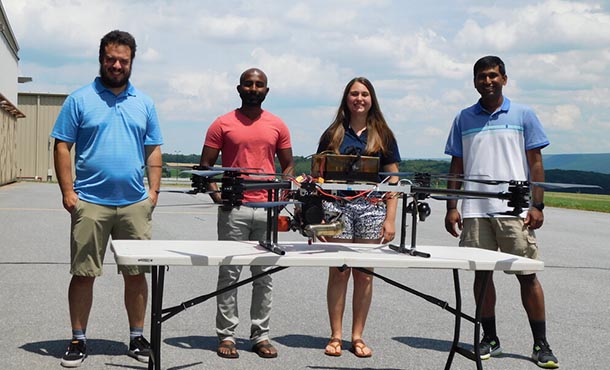
Members of the Autonomous Robotics Competition Club, from left, Vitor Valente, Vidullan Surendran, Rachel Axten and Venkatakrishnan Iyer, display their drone at the Mid-State Regional Airport before competition organizers recorded its flight duration. IMAGE: SUBMITTED/AUTONOMOUS ROBOTICS COMPETITION CLUB
Autonomous Robotics Competition Club wins $30K at drone contest
7/20/2021
By Mariah Chuprinski
UNIVERSITY PARK, Pa. — A team of Penn State aerospace engineering graduate students interested in unmanned aerial vehicles, or UAVs, recently won third place at the First Responder UAS Endurance Challenge, taking home $30,000 in prize money.
Hosted by the National Institute of Standards and Technology and sponsored by the United States Department of Commerce, the competition challenged more than 20 university and industry groups to design and build drones and the accompanying flight software. The competition focused on using drone technology to help first responders during critical, life-saving missions, like during a forest fire, for example. Teams were judged on longest flight duration and other categories, like overall design and least expensive drone.
Penn State placed third place in the longest flight duration category, receiving $20,000. The team also earned the first responders’ choice award and an award for drone autonomy, both worth $5,000. The team plans to use the money for future competition expenses.
The Autonomous Robotics Competition Club (ARCC), co-founded by Vidullan Surendran, a doctoral candidate in aerospace engineering, was created for students in relevant fields of study to participate in autonomous-vehicle competitions like this one around the country.
“We use our own graduate research on robotics, artificial intelligence, sensor fusion and control theory to create UAV software that really works, and is competitive,” said Surendran, ARCC president. “We use common computer programming languages and open-source software that is accessible to everyone to develop our drone software.”
Competitions like the First Responder UAS Endurance Challenge usually involve several stages. These include designing the drone in simulation and submitting a report, building the structure and electronics hardware, designing the autonomous software and testing the drone. On the final day, the team travels to the indoor or outdoor contest venue to set it up before going head-to-head with other teams.
After ARCC succeeded in three preliminary competition stages, Endurance Challenge organizers sent a video team to the Mid-State Regional Airport in Phillipsburg to record ARCC’s drone flight. The autonomous UAV stayed above ground for over an hour while carrying a 10-pound load — which scored third in duration behind industry groups Advanced Aircraft Company and Intelligent Energy.
“Competitions like this allow us to take what we learn in class and in our research and apply it,” Surendran said. “Our club members teach each other to put into practice what we learn in class. But it’s important for engineers, especially aerospace engineers, to learn how to build and fly UAVs. All of us use the competitions as motivation to learn more.”
In addition to Surendran, participants in the First Responder UAS Endurance Challenge were Rachel Axten, Venkatakrishnan Iyer and Vitor Valente, all doctoral students in aerospace engineering. ARCC is sponsored by the University Park Allocation Committee and the Department of Aerospace Engineering. Eric Johnson, professor of aerospace engineering, serves as the club’s adviser.
“This was a tough competition,” said Amy Pritchett, professor and head of Penn State’s Department of Aerospace Engineering. “In the final phases, our student group went head-to-head with industry, the other academic teams having been washed out in earlier phases. Our team invented all the autonomy for the vehicle to completely fly itself — and took top prize for that portion of the challenge. Their achievement is remarkable.”



